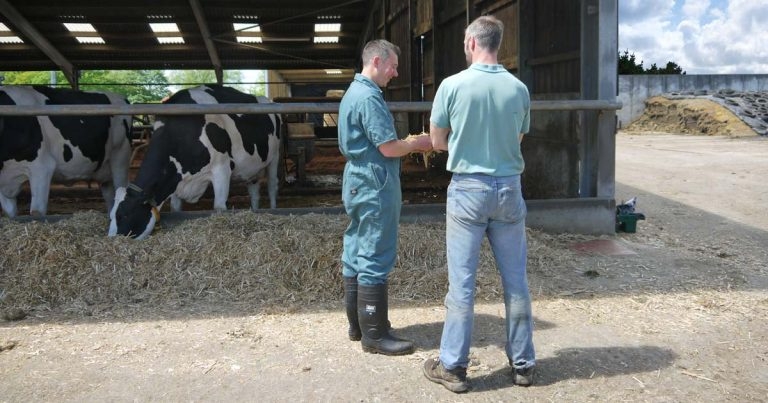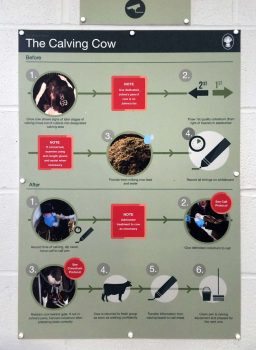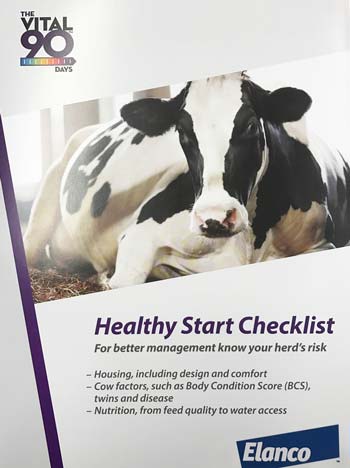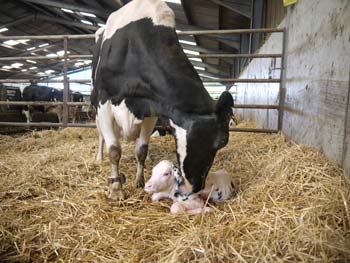18 Apr 2017
Owen Atkinson delves into the history of the herd health plan, before explaining why “herd health management” is perhaps a better term – and going on to explain how vets could successfully implement excellent on-farm protocols.

Figure 4. How effective are our on farm conversations with clients? Maybe not as much as we imagine.
The traditional aims of herd health planning – bringing all the protocols a farmer may find useful together in one document – are laudable. However, many farmers view them as tick-box exercises, while quite a few vets have bad experiences of putting them together at extremely short notice. The author delves into the history of the herd health plan, before explaining why “herd health management” is perhaps a better term – and going on to explain how vets could successfully implement excellent on-farm protocols.
Let us begin with a bit of history. A dairy herd health plan became an entity in 1995, when the National Dairy Farm Assurance Scheme, pre-dating Red Tractor, recommended each dairy farm had one.

Ideally, the herd health plan was signed by the farm’s vet. It was considered better if it was written by the vet. Coinciding, as this period did, with the growing widespread use of computers and word-processors, the BCVA developed the “BCVA Dairy Herd Health Plan”. This was a large document to be completed by the vet, detailing anything and everything from what to do with a downer cow, to mastitis treatment protocols and vaccination protocols.
Through no one’s fault or intention, herd health planning was arguably reduced to an inch-thick wad of printed A4 paper in a file no one read, but took hours of (usually unpaid) work for vets to complete.
Despite these efforts – and a laudable aim of bringing together in one document all protocols a farmer might find useful – in fact, the majority of farmers seemed to view the herd health plan as a right royal pain in the backside. For many of them, it represented another tick in the box they needed to have if they wanted to keep their milk purchaser happy. Written protocols can be excellent, but they are preferably devised together and displayed appropriately (Figure 1).
In fact, the author would suggest the concept of a “herd health plan” is so deeply tarnished we should avoid the word “plan” altogether. “Herd health management” may be better.
“It is fine to celebrate success, but it is more important to heed the lessons of failure” (Bill Gates).
From the beginning, it was always recognised it would take a long time to properly document a farm’s herd health management practices. When it comes to time, as well as money, all farmers complain they have none to spare.
Thus, to avoid sitting in front of a computer alone for many hours typing the document, it was suggested the plan was developed piecemeal over several months, taking one aspect at a time in conjunction with the farmer, perhaps at his or her kitchen table. For example, lameness protocols could be discussed and documented one month; parasite control the next. In other words, eat the elephant one bite at a time.
In all his years in practice, not only did the author spectacularly fail in this task, but he knew of no other vet who succeeded, either. Often, this was because the farmer would ring the practice giving 24 hours’ notice he or she needed his or her health plan for a farm assurance visit the following day. Sometimes, if you had a very progressive client, you would get a week.
So, every health plan the author ever prepared, or, indeed, any he is aware was prepared by others, was done in isolation, not over a cosy cup of tea and scones at the farmer’s table, but usually late at night or over a weekend, in front of a slow, decrepit practice computer. Because, and the author is sure many of you will have shared his same pain, the BCVA herd health plan software was only ever able to be licensed for a single computer.
In reality, as we all tell ourselves, our more effective herd health management is done while operating on a cow with left displaced abomasum (LDA), or pregnancy diagnosing 30 cows at the routine visit. Conversations are then had regarding the thoughts on the likes of LDA prevention or infectious bovine rhinotracheitis (IBR) control. Or, more likely, if we are entirely honest with ourselves, the weekend’s football results, or local gossip, or farming woes, or, if we are lucky, some good jokes.

“Health packages” have come along since the early days of documented herd health plans. One of the first in the UK was the (DairyCo) Mastitis Control Plan. This was soon followed by the Healthy Feet Programme. Both of these tackle important endemic disease entities, common to all dairy herds, in a logical manner, and both are designed to reach a sensible “herd diagnosis” and allow development of action plans, tailored to the specific farm.
Approaches to health management in targeted areas, packaged up in some way, have a potential advantage for vets by allowing the advisory service to be sold to the farmer. This is something the original herd health planning concept somehow lacked.
Such packages are in no way restricted to the two examples given; many veterinary practices have developed their own packages – for example, in youngstock health – or have adapted a package to better meet their clients’ needs, and to develop their practice brand.
Pharmaceutical companies have also helped develop health packages – for example, the “Healthy Start Checklist” for transition cow management (Figure 2).
Another advantage of the package approach is it can potentially more clearly meet a farmer’s requirements for specific veterinary input in areas he or she is concerned about. A package also provides a welcome means of “eating the elephant” bite by bite.
Undoubtedly, health packages have moved us forwards. They will surely be developed further and evolve. However, different veterinary practices have had varied success in delivering the various packages and, as yet, the number of dairy farms directly engaged in any one type of plan or programme is still the minority.
Herd health management is always accompanied by a changing landscape. Disease prevalences rise and fall, infectious disease statuses alter with time, and risks vary.
Most farms build up a collection of lab reports and results. It often makes sense to collate these in a single place. Most commonly, this is probably a file in the farm office, but using software – particularly when it is online and can be accessed by third parties, such as the farm vet – definitely makes sense.
Several options are available for farmers and vets, with various recording options on an individual or herd level. Computerised individual cow records are invaluable and make useful data analysis possible. The milk recording organisations – in particular, the Cattle Information Service and National Milk Records – offer third-party access to vets (with clients’ permission) and data can be viewed directly or uploaded on to more specialised programmes, such as Interherd, Interherd+ or TotalVet, for detailed analysis.
In addition to systems containing individual records, records pertaining to herd health can be held by practice-specific databases or off-the-shelf software, including MyHealthyHerd and VetIMPRESS. Coupled with an engaged farmer, these systems have potential to provide great benefits to herd health management and the data handling it necessarily entails.
Two national programmes have been launched for control of the infectious diseases bovine viral diarrhoea (BVD) and Johne’s disease. In contrast to TB eradication, these are voluntary schemes, adding a further dimension to herd health management.
Control of Johne’s disease is very much an industry-driven initiative, with milk processors and retailers forever wary of the potential link of Crohn’s disease and Mycobacterium avium subspecies paratuberculosis (the cause of Johne’s disease). The initiative is overseen by the Johne’s Action Group and farmers are encouraged to adopt one of six defined control strategies for their farm. This should be overseen by a BCVA-accredited Johne’s veterinary advisor: a vet who has undergone specific online training and passed a test to demonstrate his or her own understanding.
The BVD-Free England scheme is a bit more embryonic in concept, but may share some similarities to the Johne’s scheme. Complicating the picture a little is that each of the devolved veterinary departments of Northern Ireland, Wales, England and Scotland is taking its own approach to BVD control.
The Cattle Health Certification Standards (CHeCS) is the self-regulatory body for cattle health schemes in the UK and Ireland. Farmers may voluntarily choose to belong to a CHeCS-certified scheme for any one of several infectious diseases: bTB, Johne’s disease, BVD, IBR, neosporosis and leptospirosis.
Working in conjunction with their vets, it is one way famers can either work towards or remain certified free of the diseases. CHeCS has proven to have a far greater popularity and appeal for pedigree beef farmers than dairy producers, probably mainly due to the potential economic benefit of selling certified disease-free stock.
Around 30% of UK dairy producers have “aligned contracts”, meaning they supply their milk to a particular retailer. Typically, and certainly over a long time frame, farmers on aligned contracts receive a greater milk price. In return, the retailer, such as Sainsbury’s or Tesco, sets specific herd health aspirations, which might include infectious disease control, reduced antibiotic use and targets for fertility parameters or mastitis and lameness levels.
This introduces another tier of herd health management and data recording, which, to some extent, sets a blueprint for vets to follow with these farmers. Some of the schemes include additional external veterinary support for farmers to encourage a stronger working relationship with their local vet in specific areas.
In compiling this summary of where we are at, and where we have come from with herd health management, it becomes very clear a plethora of means exists where herd health planning occurs.
Among all this “noise”, it is perhaps difficult to accurately appraise how successful vets are at implementing and conveying the key health management messages. The range of engagement or levels of success is vast. Taking a dispassionate view of the industry as whole, there is room for criticism:

Yet, on an individual farm level, some resounding success stories are available of vets and farmers working together to achieve impressive disease control and high health and welfare standards. Probably, as a whole, we are on a rising plane. The area, however, the author believes we have the greatest reason for optimism is the growing recognition how we communicate health management messages is at least as important as the message itself (Figure 3).
Around half a millennium ago, French mathematician Blaise Pascal noted “people are generally better persuaded by the reasons which they have themselves discovered than by those which have come into the mind of others”. In the art of persuasion, it is better to harness someone’s own idea than to try to impose your own.
In the world of veterinary health planning, we are shedding the shackles of our past, when we perceived vets to be the ones with all the right answers. It is becoming apparent it is far more effective to coach and mentor rather than tell a farmer what to do. It is a rare person (and the author includes farmers in this category) who ever does what someone tells them to do.
Should we ever find ourselves becoming frustrated at “banging our heads against a wall”, telling a farmer again and again to do something, we ought to perhaps take a step backwards to examine our approach.
In part, this evolution in our advisory approach is occurring alongside a generation of more business-minded and educated farmers. Our role is becoming far more a collaborator in achieving good herd health and less one who berates a farmer to make improvements.
In 2010, Jolanda Jansen, a Dutch social sciences researcher, completed her PhD on “Mastitis and farmer mindset”. It was a wide-ranging study, but one part in particular grabbed my attention. She recorded 17 different vets during on-farm communications/consultations with one particular farm client, each lasting between one and two hours. Mostly, these were during routine fertility visits.
Here is a summary of her findings:
On reading that, the author has mixed feelings, such as “thank goodness she did not record me”, “crikey, no wonder vets are considered arrogant” and “actually, I’d like to understand how I communicate with
my clients”.
The author can only speak for himself on this, but his own reasons for perhaps falling into the same traps (telling; not listening; not setting the agenda; not asking clients’ opinions) might include:
This did not mean the author was not acting in good faith. He would genuinely have his farm clients’ best interests at heart. But he wouldn’t be effective. Neither he, nor, in fact, his clients would realise it.
Slowly, he is learning to listen more and speak less: to open his ears and close his mouth. Listening is a skill, particularly active listening. His wife would say he still has a long way to go to learn the art.
Motivational interviewing is a communication style, developed in the human health field, specifically to help people make decisions and changes to achieve a goal. It is particularly suited to facilitating the work of health professionals – people just like ourselves, farm vets.
At its heart lies the belief the client already understands some pros and cons of any situation or argument – or at least the gist. When we want to help people achieve their goals, the role of the professional is to evoke “change talk” by encouraging the client to explore and voice a particular side of an argument. This would reduce “sustain talk”, which are the arguments against making a change. We must resist the “righting instinct”, which usually results in more “sustain talk”.
Let us assume, in this instance, vaccination is the positive change goal you would like to encourage and believe is best for his herd. Although the farmer may not have a thorough grasp of all the minutiae of IBR infection, you must have faith he already has in his own mind potential pros and cons, such as:
The conversation may go something like:
Farmer: “I know my herd is positive for IBR, but vaccination will just be another job for me to do.”
Vet: “But vaccination will give the cows immunity” (the righting reflex).
Farmer: “You would say that: you’d have me vaccinate for everything under the sun because it is good business for you” (resisting the righting reflex with further sustain talk).
The righting reflex is to put a counter argument to the farmer’s sustain talk. His natural response is to put forward a counter argument to your counter argument. A game of mental and verbal ping-pong occurs, but if you (the vet) are the one putting forward all the “change” arguments then the farmer is the one who necessarily presents the “sustain” arguments. This is counter-productive and likely to reinforce the opposite position required to reach the goal.
Alternatively, the conversation may go like this:
Farmer: “I know my herd is positive for IBR, but vaccination will just be another job for me to do.”
Vet: “You are a busy person and I see vaccination could be another pull on your time. What effects do you think IBR might be having on your herd?” (active listening, validating farmer’s response followed by an open question).
Farmer: “Well, I sometimes have sick cows, which could be due to IBR. I would like them to be more healthy” (change talk).
Vet: “Your lab result makes it very likely IBR is causing some sick cows, but there could be other more important effects on your herd. Would it be okay if we talked about these, too?” (validating and expanding slightly on farmer’s response, followed by asking permission to give further information).
You get the gist. The second conversation is going somewhere very different from the first.
Motivational interviewing is about establishing a rapport, identifying and focusing on the farmer’s problem, asking the right questions to evoke change talk towards a positive goal and, finally, planning how to do it and reviewing progress. Importantly, it still allows for advice to be given – but never in an unsolicited way.
This briefest of explanations barely does it justice; the author only hopes your interest is sufficiently piqued to find out more about motivational Interviewing for yourselves.
This article has meandered through the history of health planning on dairy farms, and touched on some interesting areas of development and current trends. We have ended up, quite purposefully, on the importance of communication skills. The author hopes you have enjoyed the tour.
As a vet, implementing herd health management well and effectively is a challenge. How to “get our farmers to change” is a conundrum that increasingly stimulates debate and thought among members of our profession. Ours is a “people job”, at least as much as it is an “animal job” or a “science job”, and the real skill is marrying up all those facets in just the right way.
We often kid ourselves we are implementing effective health planning during the course of our normal routine visits or conversations on farm (Figure 4). The author encourages you to challenge this assumption and leaves you with a final quote, which seems a fitting end:
“The single biggest problem in communication is the illusion that it has taken place” (George Bernard-Shaw).